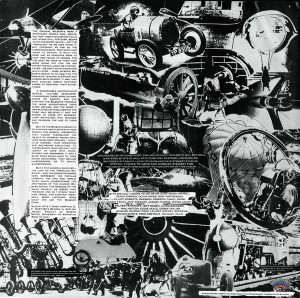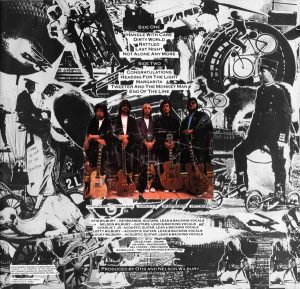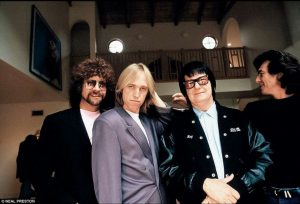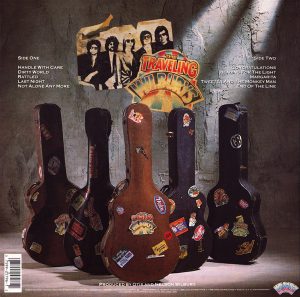by Patrick Roefflaer
This article is one of a unique series of insights into the creation of the art work within each of Bob Dylan’s albums. There is a list of all the articles in the series here.
Traveling Wilburys Vol 1
- Released: October 17, 1988
- Band photography: Neal Preston
- Sleeve photography: Gered Mankowitz and Chris Smith.
- Art-director: David Costa for Wherefore Art?
Neal Preston
Like so many American baby boomers, 12 year old Neal Preston fell in love with music after seeing the Beatles on The Ed Sullivan Show in February 1964. A few years later, he first combined this love with his other hobby, photography and started shooting rock shows throughout the New York City area. While still in high school, he formed a small photography company, earning assignments from a variety of publications.
Shortly after graduating in 1970, he moved to Los Angeles, where he became a much-in-demand photographer, covering tours by Led Zeppelin, Queen, Bruce Springsteen and The Who. He also extensively shot stars like The Rolling Stones, Fleetwood Mac, Michael Jackson, Tom Petty and many more.
Fast forward to late May 1988.
Out of the blue, he got a call from a contact to go to a house in Encino, for some shots of Tom Petty and a few friends. “Tom’s gonna call you and he’ll give you the details,” she said.
When Petty called, Preston asked for directions. In October 2017 the photographer recalled the conversation to Daily Mail: ‘“Well, it’s er, it’s um, er… here, talk to George. So he hands the phone over to a guy named George, and this guy says “Hi, this is George.”
I ask what’s the address and it’s a distinctly Liverpudlian accent and I suddenly realize it’s George Harrison. […] Now, in my world, a Beatle trumps anyone,” Preston explained, starstruck. “I’m in a haze now. I remember nothing about the rest of that phone call,” he laughs, “but I managed to write the address.”
The directions lead to a mansion on Balboa Boulevard, Encino. The house, designed by Wallace Neff, is owned by Eurythmics’ Dave Stewart. George Harrison rented the place while staying in Los Angeles to make a cameo appearance in the Hand-Made movie “Checking Out”, and helping Roy Orbison and Tom Petty with their new albums. The recording of The Traveling Wilburys album was not planned, but it was fortunate that Stewart had built a recording studio in the house.
(By the way: it turned out that Dave Stewart had forgotten to ask for permits to make changes to the building. The house has since been demolished.)
Later Dave Stewart took some credit for getting the supergroup together. In an interview to Music Radar he stated, “I was kind of the host/virtual member. They recorded it all in my house. I put Dylan together with Tom Petty … George Harrison was living in my house in Encino at the time. Everybody met up there.”
Not that he was there to witness it all. “I was busy doing quite a few things in England,” Stewart says. “That Wilburys thing happened really quickly. It all took place around my kitchen table and in my garden. I introduced everybody, went off, and when I came back they had already done it.”
Back to Neal Preston: “I get to the house about an hour later, knock on the door and a roadie lets me in and I walk in and George is sitting at the table and I see Roy [Orbison] in the kitchen mixing some tea or something and I think this is pretty wild.”
To the photographer, it is exp lained that Tom, George and Roy have just finished recording an album with Bob Dylan and ELO’s Jeff Lynne and that some pictures are needed for publicity.
lained that Tom, George and Roy have just finished recording an album with Bob Dylan and ELO’s Jeff Lynne and that some pictures are needed for publicity.
“George pulls me aside and takes me in this small room, closes the door and says: ‘Now, listen to me, Bob is in a pretty good mood. I’ll let you know when the mood is just right, I’ll give you a sign and then we’ll shoot. But we won’t shoot until Bob is ready.’
“Then Tom Petty walks in, gives me a hug and says: ‘Now, Bob’s in an ok mood’.”
“It’s all the same thing. They’re walking on eggshells around Bob Dylan.”
Sometime later, Preston is lead to another room, where Bob is playing pinball. While the other four line up before the lens, Bob doesn’t want to finish his game yet. So, the first shot Preston took, Bob is way in the background hunched over the pinball machine. “I’ve been around Bob before, and Bob’s a good guy. But, you know, he’s Bob Dylan,” Preston said. “We all have our good days and bad days in our lives.”
Sometime later, Bob is ready to join his bandmates. The shoot lasts about an hour. There are pictures made in the house and in the garden.
It is a bit of a surprise for the photographer that two of his pictures are given to/chosen by art director David Costa to use for the album sleeve. One of these is even used twice: on the front and the back, while another – the five musicians with their guitars – is used for the inner sleeve front.
 “It was never meant to be the iconic Wilbury shoot,” Preston said.
“It was never meant to be the iconic Wilbury shoot,” Preston said.
David Costa
The English graphic designer David Costa was probably chosen by George Harrison, as he had recently done the artwork for his comeback album Cloud Nine. (The collaboration would continue with The Very Best of Dark Horse and both the remastered and repackaged Concert for Bangladesh and All Things Must Pass.)
Costa designed the Traveling Wilburys logo.
Besides Neil Preston, two other photographers are mentioned for the sleeve art: Gered Mankowitz and Chris Smith. Mankowitz is best known for his photographs of the Rolling Stones in their prime. He‘s a longtime friend and associate of Costa. But nothing is known of Smith.
When asked, Mr Mankowitz confirmed to me: “I shot the back cover image of the guitar cases in my studio”. But, he added: “I have no idea of who Chris Smith is…………….!”
There’s a Chris Smith, who has been at the forefront of British sports photography for over thirty years. His career started at the Observer newspaper in 1970. Six years later he joined The Sunday Times, where he has worked for over thirty years. He took the famous photograph of The Beatles with Cassius Clay. But that’s his only brush with the world of pop music. So, I doubt he is our man.
Perhaps the mysterious Smith lived at the beginning of last century and made the vintage photo’s used for the collage on the inner sleeves. Who knows?
The inner sleeve features a story full of puns about the Wilbury name, by Hugh Jampton (there’s one). Behind that pseudonym hides one Michael Palin, of Monty Python’s fame.
What else is on the site?
We have a very lively discussion group “Untold Dylan” on Facebook with over 3330 active members. (Try imagining a place where it is always safe and warm). Just type the phrase “Untold Dylan” in, on your Facebook page or follow this link
You’ll find some notes about our latest posts arranged by themes and subjects on the home page of this site. You can also see details of our main sections on this site at the top of this page under the picture.
The index to all the 597 Dylan compositions and co-compositions that we have found on the A to Z page.
If you are interested in Dylan’s work from a particular year or era, your best place to start is Bob Dylan year by year.
On the other hand if you would like to write for this website, or indeed have an idea for a series of articles that the regular writers might want to have a go at, please do drop a line with details of your idea, or if you prefer, a whole article to Tony@schools.co.uk
And please do note our friends at The Bob Dylan Project, which lists every Dylan song in alphabetical order, and has links to licensed recordings and performances by Dylan and by other artists, plus links back to our reviews (which we do appreciate).





